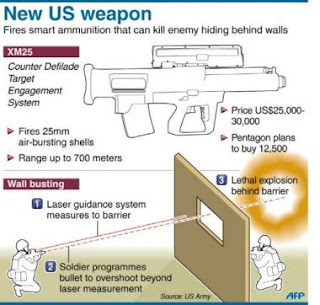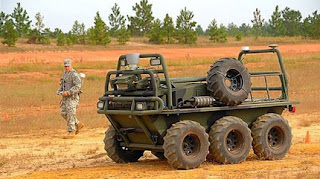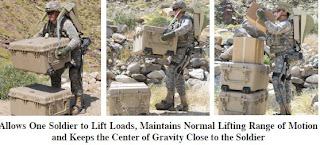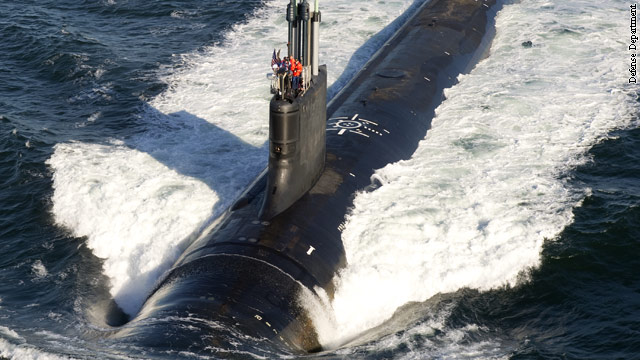JayAtl
BANNED

- Joined
- Nov 18, 2010
- Messages
- 8,812
- Reaction score
- -14
Top Ten future weapons 2011-2020 for the US army
These are soon to be deployed or have been deployed!~.
1. After years of development, the U.S. Army has unleashed a new weapon in Afghanistan -- the XM25 Counter Defilade Target Engagement System, a high-tech rifle that can be programmed so that its 25-mm. ammunition detonates either in front of or behind a target, meaning it can be fired just above a wall before it explodes and kills the enemy. Deployment started in November of 2010 and there will be one XM25 per squad after the first phase.

2. Starting in January 2011, US snipers will be outfitted with the XM2010 rifle, capable of hitting a target from a 3,937-foot distance — about three quarters of a mile. The current sniper rifle, the M-24, has a range of 2,625 feet, by contrast.

3. Darpa will rollout the project “One Shot” that aims to deliver sniper rifles whose accuracy won’t be thrown off by high-velocity winds. Those are supposed to arrive in 2011, too.
4. Lockheed Martin’s (LM) Squad Mission Support System (SMSS) has passed a final round of tests at Fort Riley, Kansas, before scheduled deployment to Afghanistan in 2011. The system, which turns a six-wheeled amphibious ATV into a robotic packhorse and charging station, has been subjected to a variety of simulated warzone environments in both remote controlled and fully autonomous modes"

The SMSS can carry a squad's food supplies, water, batteries, heavy weapons, ammunition, survival gear and can even accommodate casualties. Besides transporting up to 600lbs (272 kg) of gear, the SMSS also provides two to four kilowatts of power, and is capable of charging 146 batteries within ten hours.
5. In 2012, Darpa contractor Teledyne is scheduled to deliver a prototype of a smart .50-caliber bullet that can adjust its trajectory for wind and humidity fluctuations.
6. The HULC is a lower-body, electro-hydraulically-powered exoskeleton designed to lift and carry heavy loads. It should start seeing deployment in 2015 with an expected 10,000 by 2020. They help a soldier to life 200 pounds without strain, currently need about 1000 watts of power.

The HULC can assist speed marching at up to 7 mph reduces this somewhat; a battery-draining "burst" at 10mph is the maximum speed
A soldier with a pack would normally go at 3 mph maximum and cover 10-12 miles in a day.
7. It is possible that by 2020 the Lasermotive laser powered UAVs could be deployed. These UAVs would be able to keep flying with remote recharging from a ground based laser. The ground based laser and generator could be a current Hummer, MRAP or Squad Mission Support System.
8. Quadcopter UAVs could be run from the Squad Mission Support System to provide a variety of services.
* aerial surveillance
* Laser targeting for weapons
* delivery service of ammo, weapons or other supplies from the Squad Mission Support System
The system for loading different things into the UAV (based on a short command transmitted from someone up to a few miles away) could be like the automatic data cartridge loaders used in data centers. The UAVs would be sitting on top of the Squad robot vehicle where different stacks of cartridges could be loaded. The stack would rotate to the right cartridge and then get fed into a payload area. Then the UAV would fly and deliver it to soldiers up to a few miles away.
In the movie Saving Private Ryan, the character Upham was a runner with more ammo for the other soldiers. The UAV delivery service would be similar but faster and reliable.
The UAVs with extra power supplies from the Squad ground robot would provide a level of always available close air support to the squads.
9. The DARPA flying hummer project could also see some deployments by 2020
* flying/driving range of 250 miles
* measure no more than 30 feet long by 8.5' wide and 9' high
* perform vertical take-off and landing
* carry four people
* perform unmanned operations
* and be easy enough to control that anyone who can drive a Humvee can also pilot the vehicle.
* Capable of handling small arms fire
* Quick entry and exit
DARPA imagines that the vehicle could use
* hybrid electric drive
* adaptive wing structures
* ducted fan propulsion systems
* and lightweight heavy fuel engines.
10. Plasma antennas will enable more compact pain guns with individual targeting capabilities. Plasma antennas will also enable multi-gigabit communication speeds for everyone.
Plasma antennas have a number of possible applications in the defence, space and homeland security sectors, including:
* Secure Battlefield Communications
* Low Probability of Detection Radar
* Electronic Warfare (e.g. Electronic Countermeasures ECM and Electronic Surveillance Measures ESM)
* Communications Intelligence (COMINT)
* Electronic Intelligence (ELINT)
* Border Protection & Perimeter Monitoring
* Communications with Remotely Piloted Vehicles (e.g. UAVs)
* IFF And NCTR
* Multi-purpose Common Aperture Applications
New Scientist has a video of top 5 army gadgets from the recent Army Science Conference.
The army of the future will rely heavily on robots and virtual reality.
1. Virtual soldiers will help medics learn to recognize and treat symptoms of post-traumatic stress disorder and other mental illnesses.
2. Ground-based robots will swarm urban streets, building up real-time maps for urban combat.
3. Bird-sized quadcopters will hover through debris-strewn battlefields to surveil the enemy.
4. Robotic hands could take a few lessons from the versatile squid tentacle.
5. tiny mechanical wings could lead to impossibly small cyberflies on the wall.
These are soon to be deployed or have been deployed!~.
1. After years of development, the U.S. Army has unleashed a new weapon in Afghanistan -- the XM25 Counter Defilade Target Engagement System, a high-tech rifle that can be programmed so that its 25-mm. ammunition detonates either in front of or behind a target, meaning it can be fired just above a wall before it explodes and kills the enemy. Deployment started in November of 2010 and there will be one XM25 per squad after the first phase.

2. Starting in January 2011, US snipers will be outfitted with the XM2010 rifle, capable of hitting a target from a 3,937-foot distance — about three quarters of a mile. The current sniper rifle, the M-24, has a range of 2,625 feet, by contrast.

3. Darpa will rollout the project “One Shot” that aims to deliver sniper rifles whose accuracy won’t be thrown off by high-velocity winds. Those are supposed to arrive in 2011, too.
4. Lockheed Martin’s (LM) Squad Mission Support System (SMSS) has passed a final round of tests at Fort Riley, Kansas, before scheduled deployment to Afghanistan in 2011. The system, which turns a six-wheeled amphibious ATV into a robotic packhorse and charging station, has been subjected to a variety of simulated warzone environments in both remote controlled and fully autonomous modes"

The SMSS can carry a squad's food supplies, water, batteries, heavy weapons, ammunition, survival gear and can even accommodate casualties. Besides transporting up to 600lbs (272 kg) of gear, the SMSS also provides two to four kilowatts of power, and is capable of charging 146 batteries within ten hours.
5. In 2012, Darpa contractor Teledyne is scheduled to deliver a prototype of a smart .50-caliber bullet that can adjust its trajectory for wind and humidity fluctuations.
6. The HULC is a lower-body, electro-hydraulically-powered exoskeleton designed to lift and carry heavy loads. It should start seeing deployment in 2015 with an expected 10,000 by 2020. They help a soldier to life 200 pounds without strain, currently need about 1000 watts of power.

The HULC can assist speed marching at up to 7 mph reduces this somewhat; a battery-draining "burst" at 10mph is the maximum speed
A soldier with a pack would normally go at 3 mph maximum and cover 10-12 miles in a day.
7. It is possible that by 2020 the Lasermotive laser powered UAVs could be deployed. These UAVs would be able to keep flying with remote recharging from a ground based laser. The ground based laser and generator could be a current Hummer, MRAP or Squad Mission Support System.
8. Quadcopter UAVs could be run from the Squad Mission Support System to provide a variety of services.
* Laser targeting for weapons
* delivery service of ammo, weapons or other supplies from the Squad Mission Support System
The system for loading different things into the UAV (based on a short command transmitted from someone up to a few miles away) could be like the automatic data cartridge loaders used in data centers. The UAVs would be sitting on top of the Squad robot vehicle where different stacks of cartridges could be loaded. The stack would rotate to the right cartridge and then get fed into a payload area. Then the UAV would fly and deliver it to soldiers up to a few miles away.
In the movie Saving Private Ryan, the character Upham was a runner with more ammo for the other soldiers. The UAV delivery service would be similar but faster and reliable.
The UAVs with extra power supplies from the Squad ground robot would provide a level of always available close air support to the squads.
9. The DARPA flying hummer project could also see some deployments by 2020
* flying/driving range of 250 miles
* measure no more than 30 feet long by 8.5' wide and 9' high
* perform vertical take-off and landing
* carry four people
* perform unmanned operations
* and be easy enough to control that anyone who can drive a Humvee can also pilot the vehicle.
* Capable of handling small arms fire
* Quick entry and exit
DARPA imagines that the vehicle could use
* hybrid electric drive
* adaptive wing structures
* ducted fan propulsion systems
* and lightweight heavy fuel engines.
10. Plasma antennas will enable more compact pain guns with individual targeting capabilities. Plasma antennas will also enable multi-gigabit communication speeds for everyone.
Plasma antennas have a number of possible applications in the defence, space and homeland security sectors, including:
* Secure Battlefield Communications
* Low Probability of Detection Radar
* Electronic Warfare (e.g. Electronic Countermeasures ECM and Electronic Surveillance Measures ESM)
* Communications Intelligence (COMINT)
* Electronic Intelligence (ELINT)
* Border Protection & Perimeter Monitoring
* Communications with Remotely Piloted Vehicles (e.g. UAVs)
* IFF And NCTR
* Multi-purpose Common Aperture Applications
New Scientist has a video of top 5 army gadgets from the recent Army Science Conference.
The army of the future will rely heavily on robots and virtual reality.
1. Virtual soldiers will help medics learn to recognize and treat symptoms of post-traumatic stress disorder and other mental illnesses.
2. Ground-based robots will swarm urban streets, building up real-time maps for urban combat.
3. Bird-sized quadcopters will hover through debris-strewn battlefields to surveil the enemy.
4. Robotic hands could take a few lessons from the versatile squid tentacle.
5. tiny mechanical wings could lead to impossibly small cyberflies on the wall.
Last edited by a moderator:





 I will add pictures slowly...
I will add pictures slowly...



 --->NOBODY!
--->NOBODY!
